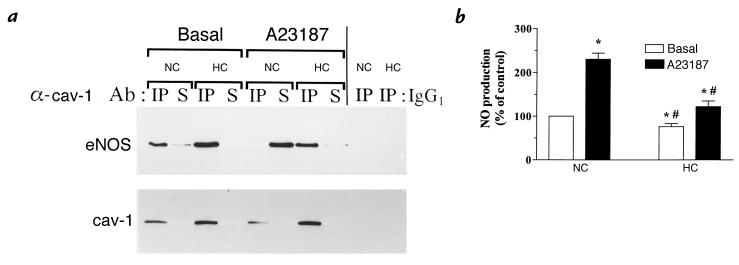Figure 2.
High plasma cholesterol levels stabilize the caveolin–eNOS interaction and decrease NO production in endothelial cells. Endothelial cells exposed to normocholesterolemic (NC; 179 ± 10 mg/dl) or hypercholesterolemic (HC; 298 ± 14 mg/dl) human serum were incubated for 5 min in the presence or absence of the calcium ionophore A23187 (5 μM) and either tested for NO production or collected, lysed, and solubilized as described in the text. (a) Cell extracts were immunoprecipitated with anti–caveolin-1 antibody (lanes 1–8) or irrelevant IgG1 (lanes 9–10), as indicated. Both the immunoprecipitate and supernatant fractions were then separated on SDS-PAGE and immunoblotted with two different antibodies. Top: Immunoblot with an anti-eNOS antibody of caveolin immunoprecipitates (IP) and of the remaining supernatant (S). Note that to obtain the S fraction, the supernatants from the IP were immunoprecipitated with eNOS antibody in order to detect quantitatively the amount of eNOS left behind the initial caveolin IP. Note also that the sum of eNOS protein detected in the caveolin IP and supernatant is equal for the different conditions. Bottom: Immunoblot with an anti–caveolin-1 antibody of caveolin immunoprecipitates (IP) and of the remaining supernatant fractions (S). Note that to obtain the S fractions, the supernatants from the caveolin IP were again immunoprecipitated with anti–caveolin-1 antibody in order to detect quantitatively the amount of caveolin left behind the initial IP. These experiments were performed three times with similar results. (b) A bar graph (mean ± SEM, n = 9) illustrating the NO production (measured with a microsensor) at the basal level (open bars) and after exposure to A23187 (filled bars) in cultures of endothelial cells treated with NC or HC human serum; the data are expressed as percent of NO production in nonstimulated cells exposed to NC serum. *P < 0.05 vs. basal, NC condition. #P < 0.01 vs. stimulated NC condition. NO, nitric oxide.

